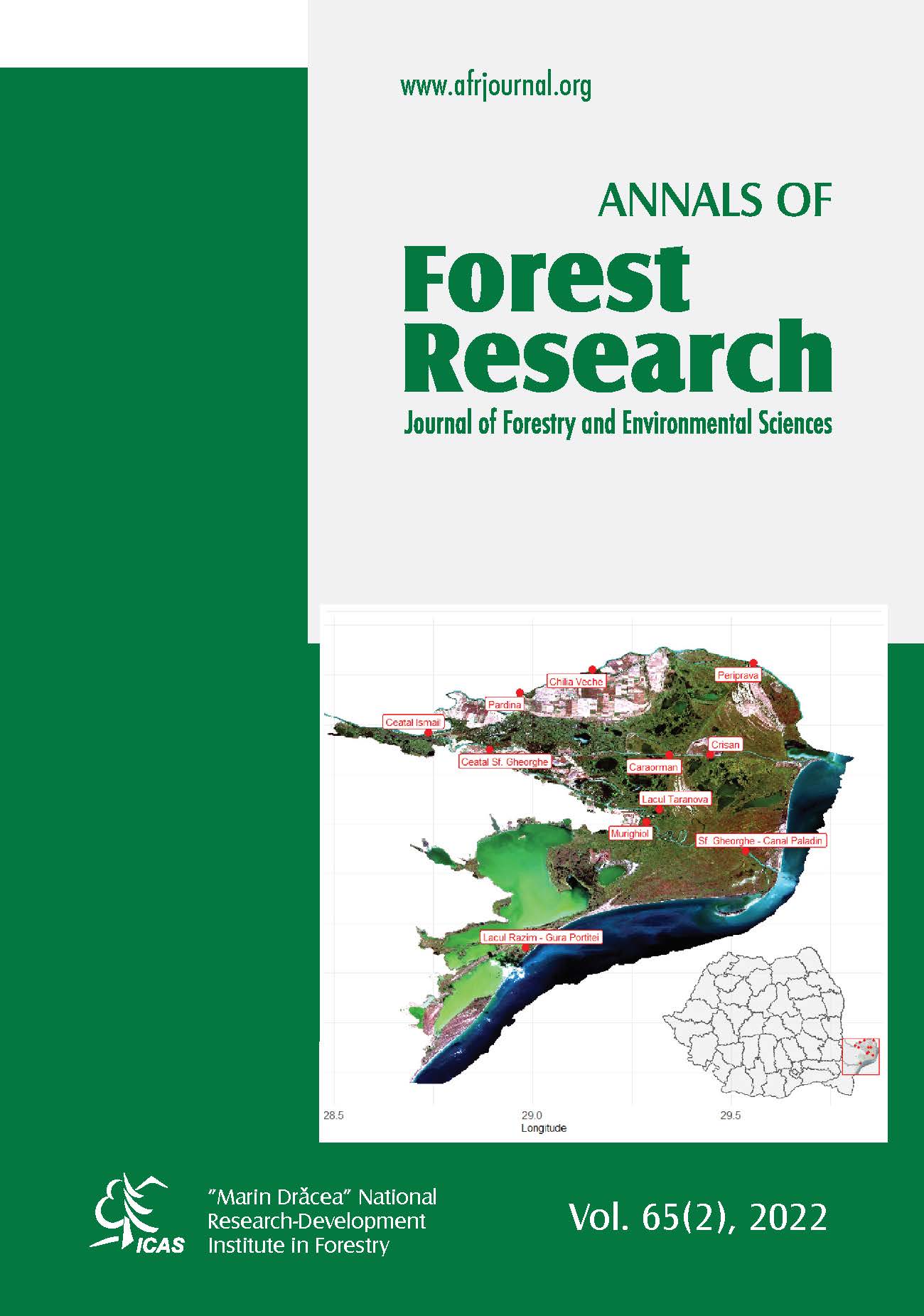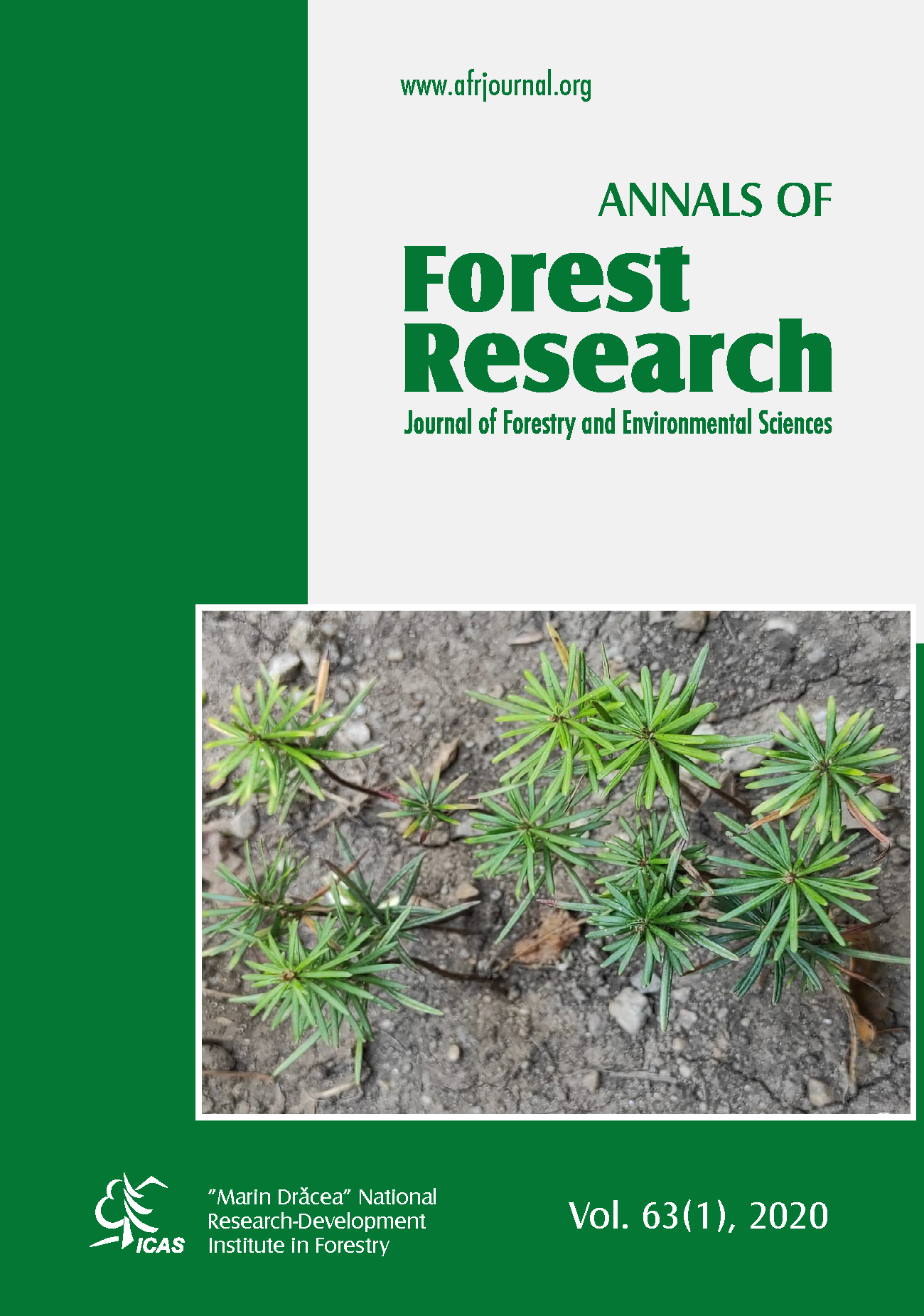How accurate is the remote sensing based estimate of water physico-chemical parameters in the Danube Delta (Romania)?
DOI:
https://doi.org/10.15287/afr.2022.2682Keywords:
Danube Delta, water quality, remote sensing, Sentinel 2Abstract
The current paper estimated the physico-chemical properties of water in the Danube Delta (Romania), based on Sentinel 2 remote sensing data. Eleven sites from the Danube Delta were sampled in spring and autumn for three years (2018-2020) and 21 water physico-chemical parameters were measured in laboratory. Several families of machine learning algorithms, translated into hundreds of models with different parameterizations for each machine learning algorithm, based on remote sensing data input from Sentinel 2 spectral bands, were employed to find the best models that predicted the values measured in laboratory. This was a novel approach, reflected in the types of selected models that minimised the values of performance metrics for the tested parameters. For alkalinity, calcium, chloride, carbon dioxide, hardness, potassium, sodium, ammonium, dissolved oxygen, sulphates, and suspended matter the results were promising, with an overall percentage bias of the estimates of +/- 10% from the observed values. For copper, magnesium, nitrites, nitrates, turbidity and zinc the estimates were fairly accurate, with percentage biases in the interval +/- 10% - 20%, whereas for detergents, led, and phosphates the percentage bias was higher than 20%. Overall, the results of the current study showed fairly good estimates between remote sensing based estimates and laboratory measured values for most water physico-chemical parameters.References
Alvado B., Sòria-Perpinyà X., Vicente E., Delegido J., Urrego P., Ruíz-Verdú A., Moreno J., 2021. Estimating organic and inorganic part of suspended solids from Sentinel 2 in different inland waters. Water 13: 2453.Brockmann C., Doerffer R., Peters M., Kerstin S., Embacher S.; Ruescas, A., 2016. Evolution of the C2RCC neural network for Sentinel 2 and 3 for the retrieval of ocean colour products in normal and extreme optically complex waters. Living Planet Symposium 740: 54.Călugăr A., Ivan O., Acatrinei L., Huțanu, M., 2017. From a green perspective: management pressures on forest ecosystems from Danube Delta Biosphere Reserve linked with soil mesofauna dynamics and foliar gas-exchange parameters. In 15th International Conference on Environmental Science and Technology, 31 August - 2 September 2017, Rhodes, Greece. CEST, pp. 29-35.Djamai N., Fernandes R., 2018. Comparison of SNAP-derived Sentinel-2A L2A product to ESA product over Europe. Remote Sensing 10: 926.Dumitru C.O., Dax G., Schwarz G., Cazacu C., Adamescu M.C.,Datcu M., 2019. Accurate monitoring of the Danube Delta dynamics using Copernicus data. In Bostater C.R., Neyt X., Viallefont-Robinet F., (ed.), Remote Sensing of the Ocean, Sea Ice, Coastal Waters, and Large Water Regions, 9-10 September 2019, Strasbourg. SPIE, pp. 111-122.Efron B., Tibshirani R. J., 1993. An Introduction to the Bootstrap. Chapman & Hall/CRC, United Kingdom.European Parliament and European Council. 2000. Water Framework Directive.Gâştescu P., 2009. The Danube Delta biosphere reserve. Geography, biodiversity, protection, management. Revue Roumaine de Géographie 53: 139-152.Geurts P., Ernst D., Wehenkel L., 2006. Extremely randomized trees. Machine Learning 63: 33-42.Gholizadeh M.H., Melesse A.M., Reddi L., 2016. A comprehensive review on water quality parameters estimation using remote sensing techniques. Sensors 16: 1298.Goodfellow I., Bengio Y.,Courville A., 2016. Deep Learning. MIT Press, Massachusetts, United States of America, 356 p.Hastie T.J.,Tibshirani R.J., 1990. Generalized Additive Models. Chapman & Hall/CRC, London, United Kingdom, 307 p.Hyndman R.J., Koehler A.B., 2006. Another look at measures of forecast accuracy. International Journal of Forecasting 22: 679–688.Ielenicz M., Comanescu L., 2006. Romania touristic potential.EdituraUniversitara, Bucharest, Romania, 174 p.Ogashawara I., 2021. Bibliometric Analysis of Remote Sensing of Inland Waters Publications from 1985 to 2020. Geographies 1: 346-361International Standards Organisation (ISO), 1989. Thermal insulation – Heat transfer by radiation – Physical quantities and definitions.Jørgensen B., 1997.The Theory of Dispersion Models. Chapman &Hall, London, United Kingdom, 473 p.Jugaru-Tiron L., Le Coz J., Provansal M., Panin N., Raccasi G., Dramais G.,Dussouillez, P., 2009. Flow and sediment processes in a cutoff meander of the Danube Delta during episodic flooding. Geomorphology 06: 186 – 197.Kabolizadeh M., Rangzan K., Zareie S., Rashidian M., Delfan H., 2022. Evaluating quality of surface water resources by ANN and ANFIS networks using Sentinel-2 satellite data. Earth Science Informatics 15: 523-540.Karaska M.A., Huguenin R.L., Beacham J.L., Wang M.H., Jensen J.R., Kaufmann R.S.,2004. AVIRIS measurements of chlorophyll, suspended minerals, dissolved organic carbon, and turbidity in the Neuse River, North Carolina. Photogrammetric Engineering & Remote Sensing 70: 125-133.LeDell E., 2015. Scalable Ensemble Learning and Computationally Efficient Variance Estimation. PhD, University of California, Berkley, United States of America, 251 p.Mobley C.D., 2022. The Oceanic Optics Book. International Ocean Colour Coordinating Group (IOCCG), Dartmouth, NS, Canada, 924 p.Niculescu S., Lardeux C.,Hanganu, J., 2017. Synergy between Sentinel-1 radar time series and Sentinel-2 optical for the mapping of restored areas in Danube delta. In Brewer C.A. (ed.), Proceedings of the International Cartographic Association, Strasbourg, 9-11 September, pp. 1-10.Nedler J., Wedderburn R., 1972. Generalized Linear Models. Journal of the Royal Statistical Society: Series A 153: 370-384.Oteman B., Scrieciu A., Bouma T.J., Stanica A., van der Wal D., 2021. Indicators of expansion and retreat of Phragmites based on optical and radar satellite remote sensing: a case study on the Danube delta. Wetlands 41: 1-15.Pacioglu O., Duţu L., Duţu F., Pavel A.B.,2022. Habitat preferences and trophic interactions of the benthic invertebrate communities inhabiting depositional and erosional banks of a meander from Danube Delta (Romania). Global Ecology and Conservation 38: e02213.Pahlevan N., Smith B., Schalles J., Binding C., Cao Z., Ma R., Stumpf R., 2020. Seamless retrievals of chlorophyll-a from Sentinel-2 (MSI) and Sentinel-3 (OLCI) in inland and coastal waters: A machine-learning approach. Remote Sensing of Environment 240: 111604.Pereira-Sandoval M., Ruescas A., Urrego P., Ruiz-Verdú A., Delegido J., Tenjo C., Moreno J., 2020. Evaluation of atmospheric correction algorithms over Spanish inland waters for sentinel-2 multi spectral imagery data. Remote Sensing 11: 1469.Rahul T.S., Brema J., Wessley G., 2022. Evaluation of surface water quality of Ukkadam lake in Coimbatore using UAV and Sentinel-2 multispectral data. International Journal of Environmental Science and Technology, 1-16.Rivera J.P., Verrelst J., Delegido J., Veroustraete F., Moreno J., 2014. On the Semi-Automatic Retrieval of Biophysical Parameters Based on Spectral Index Optimization. Remote Sensing 6: 4927–4951.Smith D.M., Clarke G.P., Harland K., 2009. Improving the synthetic data generation process in spatial microsimulation models. Environment and Planning A: Economy and Space 41: 1251-1268.Soltana G.,Sabetzadeh M., Briand L.C., 2017. Synthetic data generation for statistical testing. In IEEE/ACM International Conference on Automated Software Engineering, Urbana-Champaign, IL, USA, 12-19 October 2017. IEEE, pp. 872-882.Soomets T., Uudeberg K., Jakovels D., Brauns A., Zagars M., Kutser T., 2020. Validation and comparison of water quality products in Baltic lakes using Sentinel-2 msi and Sentinel-3 OLCI data. Sensors 20: 742.Stoica C., Camejo J., Banciu A., Nita-Lazar M., Paun I., Cristofor S., ... Guevara M., 2016. Water quality of Danube Delta systems: ecological status and prediction using machine-learning algorithms. Water Science and Technology 73: 2413-2421.Topp, Simon N. Pavelsky, Tamlim M. Jensen, Daniel Simard, Marc, Ross, Matthew R. V. 2019 Research Trends in the Use of Remote Sensing for Inland Water Quality Science: Moving Towards Multidisciplinary Applications. Water 12(1):169van der Laan M.J., Polley E.C., Hubbard L., 2016. Super Learner. Statistical Applications in Genetics and Molecular Biology 9:1- 6.Wolpert D.H., 1992. Stacked Generalization. Neural Networks 5: 241 -259.Zhang L., Gonzalez-Garcia A., Van De Weijer J., Danelljan M., Khan F.S., 2018. Synthetic data generation for end-to-end thermal infrared tracking. IEEE Transactions on Image Processing 28: 1837-1850.Zinevici V.,Parpală L., 2006. The zooplankton structure and productivity in Danube Delta lacustrine ecosystems. In Tudorancea C., Tudorancea M. (eds.), Danube Delta. Genesis and Biodiversity. Backhuys Publishers, Leiden, pp. 177-210.
Downloads
Published
Issue
Section
License
All the papers published in Annals of Forest Research are available under an open access policy (Gratis Gold Open Access Licence), which guaranty the free (of taxes) and unlimited access, for anyone, to entire content of the all published articles. The users are free to “read, copy, distribute, print, search or refers to the full text of these articles”, as long they mention the source.
The other materials (texts, images, graphical elements presented on the Website) are protected by copyright.
The journal exerts a permanent quality check, based on an established protocol for publishing the manuscripts. The potential article to be published are evaluated (peer-review) by members of the Editorial Board or other collaborators with competences on the paper topics. The publishing of manuscript is free of charge, all the costs being supported by Forest Research and Management Institute.
More details about Open Access:
Wikipedia: http://en.wikipedia.org/wiki/Open_access





